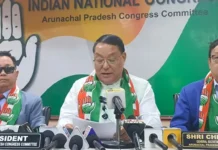DIRANG, 26 Nov: The National Research Centre on Yak (NRCY) here in West Kameng district conducted a training programme on ‘Scientific use of yak fibres with special reference to chamar (tanning leather)-making for better economic returns of yak farmers’, here on 24 November.
During the programme, 50 yak rearers from different parts of Dirang circle were taught the techniques of chamar-making.
Owing to their versatility, yak fibres have been used traditionally for making different products, such as tents, caps and bags used by the yak herders in extremely harsh and cold climatic condition. A yak herd produces hair/fibres, comprising an outer coarse fibre and an inner fine fibre. While the inner fibre is popular among the yak rearers for preparation of different garments, the outer coarse hair has limited use due to its slippery and coarse nature.
“Chamar is one of the best products made from the coarse fibre of yak tail. It is a ceremonial fly-whisk and is a royal symbol of great antiquity. In India, chamar was regarded sacred and was used in religious practices by both Hindus and Sikhs. Besides, it is also used as a decorative item and is popular among the tourists,” the NRCY stated in a release.
“Traditionally, yak herders make chamar from yak hair either after slaughter or death of the animal. They prepare it with intact skin, which needs special care and attention for keeping the product safe from microbial spoilage and damage. Moreover, the use of animal skin may hurt the sentiments of vegetarians.
“Looking at its great demand among the tourists as well as the locals of Arunachal Pradesh, the NRCY has taken an initiative to develop a designer chamar, using long coarse yak hairs, fixed with designer wooden handle. This institute will produce chamar regularly, shearing long yak hairs annually, without waiting for their sacrifice or death, and motivate the yak farmers through different capacity-building programmes,” it said.
At the end of the programme, all the participating yak rearers were provided with supportive inputs like best quality tents, kits for chamar-making, and basic veterinary medicines for their animals.
NRCY Director Dr Mihir Sarkar advised the yak rearers to undergo training at the NRCY “to make your yak farming more remunerative.”






